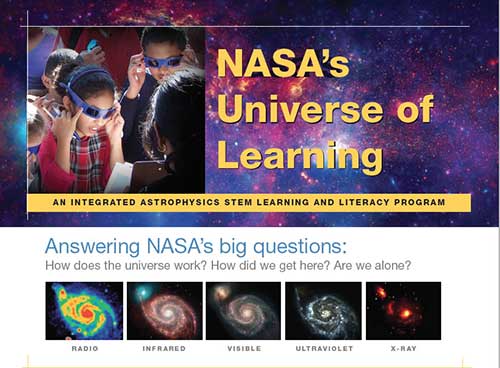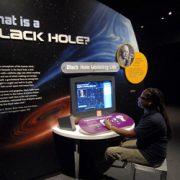Smithsonian Affiliations at 25: Chapter 3: 10 Years of Reaching for the Stars Together
Affiliations Anniversary Series: 25 Years in Your Neighborhood
Chapter 3: 10 Years of Reaching for the Stars Together
By: Tricia Edwards, Deputy Director, Smithsonian Affiliations and Natalie Wimberly, Management Support Specialist and Universe of Learning Project Manager, Smithsonian Affiliations

Student astrophotographer at Carolinas Aviation Museum (Charlotte, NC). Photo credit: Carolinas Aviation Museum.
“Working with Affiliations over the last 10 years has been one of the most productive collaborations for our Science Education Department,” says Mary Dussault, a STEM education program director at Smithsonian Astrophysical Observatory (SAO) in Cambridge, MA. Since 2012, with generous support from the Smithsonian’s Youth Access Grant program (YAG), Smithsonian Affiliations and Affiliates have collaborated with SAO to bring astronomy and astrophotography education to their communities through the Youth Capture the Colorful Cosmos program (YCCC). Dussault adds, “Right from the get-go, we realized that the educational goals of the YAG program, the strategic partnership capacity and national network of Smithsonian Affiliations, and the scalable and accessible technology resources of SAO’s MicroObservatory Robotic Telescope Network were a case of the stars aligning.”
YCCC introduces communities, especially students, to the wonders of the universe. Participants can access SAO’s robotic telescopes, take images of the cosmos, and manipulate the photographs to produce their own artistic and scientific interpretations of the stars and galaxies. Along the way, they gain important technology skills and engage in—and apply—science, technology, engineering, art, and math content. As one young participant said, “I loved editing the photos. It grew my imagination and made me want to do more with it.”

Photo captured by the MicroObservatory robotic telescope (left) alongside a student’s interpretation of the image.
Many Affiliates have participated in the program for multiple years and used YCCC to reach new audiences or forge deeper partnerships with existing collaborators. One Affiliate commented, “As a direct result of implementing the program we have already begun discussions with [our local] high school to develop a more intense astronomy program for next year.”
Since 2012, YCCC has grown to include 29 Smithsonian Affiliates and has reached more than 7,000 participants across the nation.
“Each Affiliate brings particular expertise and knowledge of their local community to adapting our SAO resources and materials, thereby creating wonderful program models that we never would have anticipated on our own,” says Erika Wright, SAO Education Specialist. For example, arts educator Annette Eschelman from the Springfield Museum of Art (Springfield, OH) was able to combine visual arts and astronomical imaging techniques to engage incarcerated youth. Starr Kelly from the Abbe Museum (Bar Harbor, ME) developed a summer camp program in which indigenous knowledge of the Wabanaki Nations informed the experience of students in the local Indian Township School.

Astronomy Kit for virtual NASA UoL 2020 Programming at Cape Fear Museum (Wilmington, NC). Photo credit: Cape Fear Museum
The successful collaboration model itself has also expanded, as SAO and Affiliations have teamed up to pursue a number of other astronomy-based education programs funded by the National Science Foundation and NASA. NASA’s Universe of Learning (NASA’s UoL), for example, connects the science, technology, subject matter experts, and adventure of NASA Astrophysics with STEM concepts, education standards, and 21st century skills central to science understanding and literacy. Resulting products, programs, and professional development experiences span a spectrum of environments and applications, enabling a rich learning “ecosystem” across the traditional boundaries of education. The goal of the program is to create and disseminate education products, programs, and professional development experiences that use NASA Astrophysics science, technology, and subject matter experts to advance NASA’s Science Mission Directorate education objectives on a national scale.
In partnership with Smithsonian Astrophysical Observatory, 15 Smithsonian Affiliate partners, over the course of 3 years, were identified to join the national network of collaborators for this project. The majority of the Affiliates who participated were already building on the long-term partnerships and successful implementations of the Youth Capture the Colorful Cosmos program. Growing from these past project relationships, NASA’s UoL is able to extend its reach through Affiliates and the communities they serve.
“We have great content that we’ll share in our virtual portfolio and will gladly share with any other organization that can make use of it. I also hope to do other projects with Universe of Learning when possible.” Nathan Meyer, Cosmosphere, Hutchinson, KS
NASA’s UoL project asks 3 main questions: How does the Universe work? How did we get here? Are we alone? The project creates and delivers science and audience-driven resources along with experiences designed to engage and immerse learners of all ages and backgrounds in exploring the universe for themselves. Its main goal is to expose astrophysics content to a wider underserved audience as well as create a Community of Practice within the Affiliate partners to document, share, and discuss ideas about how this information could translate into their own institutions.

NASA’s UoL Science of Light Program at Anchorage Museum (Anchorage, AK). Photo credit: Anchorage Museum.
“Students wanted to spend more time doing these activities and engaging with astronomy related STEM resources. For some of the students, it was their first time in a planetarium, and being able to go there twice was their favorite part of the program. Others really enjoyed learning about the MicroObservatory resource and said they would continue using it on their own.” Aaron Slonecker, Anchorage Museum, Anchorage, AK
Within the 3-year program period, our Affiliate partners have created long-term NASA UoL community programs and are actively still engaged with Smithsonian Astrophysical Observatory to help broaden the scope and reach of NASA’s UoL future programming.
Through both YCCC and NASA’s UoL, Affiliates have helped to broaden access to SAO resources and magnify the reach of their expertise, all while engaging young learners in their communities in astronomy. Affiliates have also built their capacity. They have bolstered their astronomy knowledge and expertise, while also learning how to implement public workshops and programs for audiences of all ages. They have created a community of learners through online discussions and webinars, brainstormed programming ideas, and learned with and from one another.
Later this year, Smithsonian Affiliations and SAO will debut the Youth Capture the Colorful Cosmos toolkit, developed in collaboration with the Abbe Museum, Pearl Harbor Aviation Museum (Honolulu, HI), and Springfield Museum of Art. The toolkit will provide how-to instructions for accessing the MicroObservatory, along with successful YCCC program models implemented by Affiliates with different audiences and in different settings, enabling even more Affiliates and their communities to explore the wonders of the cosmos. We also look forward to rolling out the Observing with NASA program soon. Affiliates will have the opportunity to apply to host Observing with NASA kiosks that allow public audiences to request their own telescope images and to practice image processing skills. Stay tuned for more details on these two exciting projects!
Stay tuned next month for another chapter in our 25th Anniversary Series! Until then, catch up on stories you’ve missed:
- Chapter 1: The Ten Thousand Springs Pavilion
- Chapter 2: National Youth Summits











